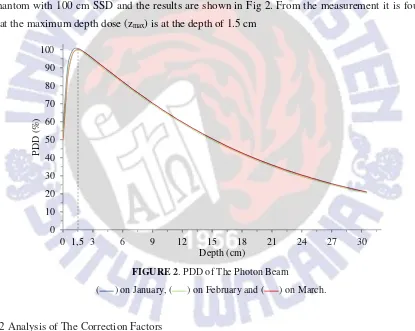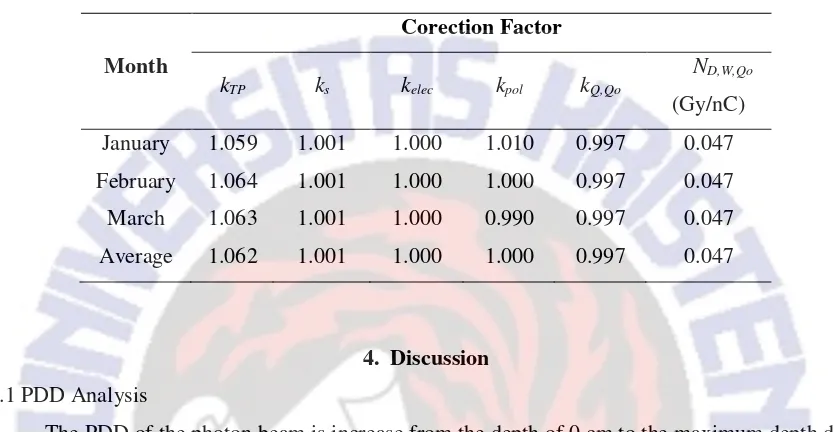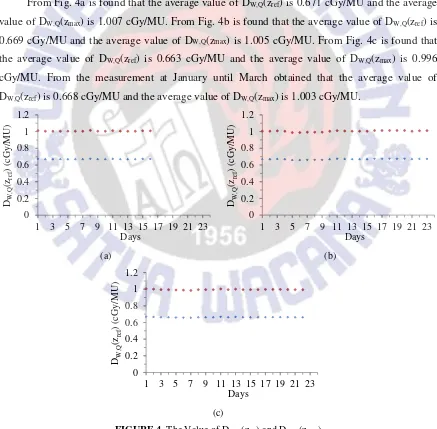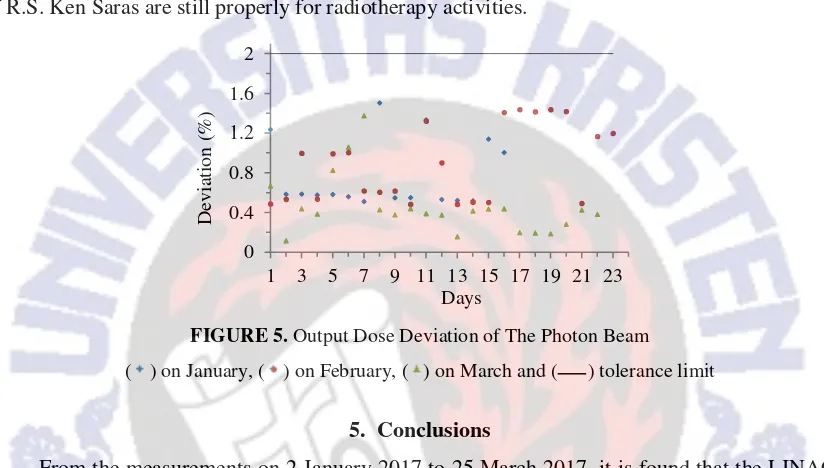Analysis of Output Dose of The Photon Beam LINAC Using TRS 398
Protocol in R.S. Ken Saras
Oleh : Wandi Wantoro NIM : 642012003
TUGAS AKHIR
Diajukan kepada Program Studi Fisika, Fakultas Sains dan Matematika guna memenuhi sebagian dari persyaratan untuk memperoleh gelar Sarjana Sains
Program Studi Fisika
FAKULTAS SAINS DAN MATEMATIKA UNIVERSITAS KRISTEN SATYA WACANA
KATA PENGANTAR
Puji syukur kehadirat Tuhan Yang Maha Esa atas berkat dan karunia-Nya, penulis dapat
menyelesaikan tugas akhir dengan judul “Analysis of Output Dose of The Photon Beam LINAC
Using TRS 398 Protocol in R.S. Ken”. Penyusunan laporan penelitian ini berguna untuk
memenuhi salah satu syarat tugas akhir dalam menyelesaikan studi fisika dan mendapatkan
gelar Sarjana Sains di Universitas Kristen Satya Wacana.
Adapun berbagai pihak yang telah membantu penulis dalam menyelesaikan tugas akhir
ini, baik secara langsung dan tidak langsung. Maka, penulis menyampaikan ucapan terima kasih
kepada semua pihak yang turut membantu yaitu :
1. Tuhan Yang Esa yang telah memberikan ridho-Nya sehingga saya diberikan kelancaran
dalam menyelesaikan tugas akhir ini dengan baik.
2. Kedua orang tua yang senantiasa mendukung baik secara moral, materiil, serta
mendoakan dan membimbing saya.
3. Kakak yang senantiasa mendukung baik secara moral, materiil, serta mendoakan dan
membimbing saya.
4. Dian Juniarti yang memberi motivasi dan dukungan.
5. Dosen-dosen yang memberi pengetahuan dan bimbingan selama perkuliahan.
6. Pembimbing lapangan yang memberi pengetahuan dan bimbingan selama pelaksanaan
tugas akhir.
7. Teman-teman angkatan 2012.
Harapannya, laporan penelitian tugas akhir ini dapat bermanfaat di masa mendatang bagi
pembaca. Penulis menyadari bahwa penyusunan tugas akhir ini memiliki banyak kekurangan.
Sebab itu, penulis membutuhkan masukan berupa saran dan kritik yang bersifat membangun
dari berbagai pihak ke arah yang lebih baik.
Salatiga, 8 September 2017
Penulis,
DAFTAR ISI
LEMBAR PENGESAHAN i
LEMBAR PERNYATAAN TIDAK PLAGIAT ii
LEMBAR PERSETUJUAN AKSES iii
KATA PENGANTAR iv
DAFTAR ISI v
JURNAL 1
LAMPIRAN
SERTIFIKAT SEMINAR SEBAGAI PEMAKALAH 11
Analysis of Output Dose of The Photon Beam LINAC Using
TRS 398 Protocol in R.S. Ken Saras
Wandi Wantoro1, Giner Maslebu1*, Suryasatriya Trihandaru1 and Muhamad Hidayatullah2
1Physic Department of Universitas Kristen Satya Wacana, Salatiga, Indonesia
2Radiotherapy Unit of Rumah Sakit Ken Saras, Ungaran, Indonesia
Abstract. Analysis of output dose of the photon beam LINAC in Radiotherapy unit of R.S. Ken Saras using TRS 398 protocol has done. This analysis was done to determine whether the output dose from photon beam LINAC in Radiotherapy unit of R.S. Ken Saras has an output dose deviation smaller than 2% or not. The measurement using Scdx-Wellhöfer FC65-G/IC70 ionization chamber in the solid water phantom with 100 cm SSD and 10 cm × 10 cm field size. From the calculation, it was found that the average output dose of the photon beam at the reference depth dose (DW,Q(zref)) was 0.668 cGy/MU and the average output dose of the photon beam at maximum depth dose (DW,Q(zmax)) was 1.003 cGy/MU. The output dose has 0.7% output dose deviation so it is concluded that the LINAC at Radiotherapy unit of R.S. Ken Saras is still properly for radiotherapy activities. Keywords: Output Dose, TRS 398, Output Dose Deviation.
2
1. Introduction
Radiotherapy is a therapy method by using ionizing radiation that is effective to treat cancer
patients.[1] In radiotherapy, there are many instruments that one of them is Linear Accelerator
(LINAC). Today there are many hospitals which use LINAC as their radiotherapy instrument.[2]
LINAC is a radiotherapy instrument which can produce an output of photon beam in MV energy
and electron beam in MeV energy.[3]
LINAC can produce photon beam by hitting accelerated electrons into heavy metal to
generated x-rays were used for cancer treatment in radiotherapy.[4] Photon beam will have
interacted with the cells of the body result of ionization and excitation on the atomic composer of
the cell then followed by the change of molecular structure of the cell so that the cell damage
occurs.[5]
Like the other radiotherapy instruments, output dose of LINAC also has output instability
because LINAC was made by interconnected electronic circuits.[6] This output instability occurs in
the output dose of the electron beam and photon beam. To overcome such instability, Quality
constancy.[9] To maintain the photon beam output constancy, analysis of output dose from photon
beam LINAC is necessary to determine whether the output dose of the photon beam is required of
calibration or still appropriate with the standards.[10] In the execution of analysis output dose of the
photon beam is known by the protocol to determining output dose Technical Report Series no. 398
(TRS 398).
TRS 398 is an international protocol which made by the International Atomic Energy
Agency (IAEA) as a code of practice for determining the absorbed dose of an external radiation
based on water absorbed dose.[11] TRS 398 is made to reduced the uncertainty by fixing an earlier
TRS based on the primary standard of air kerma for determining the absorbed dose.[12] Based on
the problems already described, it is important to analyze the output dose of the photon beam
2. Methods
2.1 Measurement The Output Dose of The Photon Beam
The measurement of output dose of the photon beam was performed on a Siemens Primus
LINAC that used in the radiotherapy unit at Ken Saras Hospital. The measurement of output dose
of the photon beam is done every 07.00 WIB except for the holidays on 2 January 2017 until 25
March 2017 according to daily QC procedure while Percentage Depth Dose (PDD) measurement is
done once in a month according to monthly QC procedure. The measurements were made with 100
cm Source to Skin Distance (SSD) and 10 cm × 10 cm field size area in the solid water phantom
using Scdx-Wellhöfer FC65-G/IC70 Farmer detector as shown in Fig 1. The irradiation was done 3
times at 300 Volt, - 300 Volt and 100 Volt with a depth of zref.
FIGURE 1. Set Up of The Output Dose Measurement
The zref or depth of the reference dose (in g/cm2) is obtained from TRS 398 and depends on
the value of Tissue Phantom Ratio (TPR20,10). The value of zref is 10 g/cm2 or 5 g/cm2 (for Co-60
photon beam) if the value of TPR20,10 is smaller than 0.7 and The value of zref is 10 g/cm2 if the
value of TPR20,10 is greater than or equal to 0.7. TPR20,10 is the ratio of Percentage Depth Dose
(PDD) at depth of 20 g/cm2 and 10 g/cm2 in water phantom which measured at 100 cm SSD and 10
cm × 10 cm field size area or can be written as,[11]
TPR20,10 =1,2661 PDD20PDD10- 0,0595 (1)
2.2 Analysis of Output Dose of The Photon Beam
To calculate the absorbed dose, it is necessary to know the value of factor correction such as
4
chamber for the effect of difference temperature and air pressure on the radiotherapy unit to the
standard reference conditions, define as,[11]
kTP = 273,15 + T273,15 + T 0
P0
P (2)
Where T is the temperature and P is the air pressure at the measurement of the photon beam,
T0 and P0 are the standard reference conditions at 20oC and 101.3 kPa air pressure. kelec is an
electrometer calibration factor whose the value is obtained from the calibration certificate of the
electrometer. ks is the correction factor of the ionization chamber response to the incomplete
collection of charge due to ion recombination, which can be written as,[11]
ks= a0 + a1 (MM1
charges at the polarizing voltages 300 Volt and M2 is measured values of collecting charges at the
polarizing voltages 100 Volt. kpol is a factor to correct the response of an ionization chamber for the
effect of a change in polarity of the polarizing voltage applied to the chamber, which can be written
as,[11]
kpol = |M+|2M + |M−| (4)
Where M+is the dosimeter readings at the polarizing voltage 300 Volt and M˗ is a dosimeter
reading at the polarizing voltage - 300 Volt. kQ,Qo is a correction factor of the difference between
the response of the ionization chamber in the quality of the used photon beam as the chamber
calibration in the reference beam quality. The value of kQ,Qo are obtained from TRS 398 which
depend on the type of used chamber and the value of the TPR20,10. ND,W,Qo is calibration factor in
terms of absorbed dose to water for a dosimeter at a reference beam quality and the value of
ND,W,Qo is 0.047 Gy/nC.
The output dose of the photon beam at reference depth dose (zref) can be expressed,[11]
DW,Q(zref) = MQ . ND,W,Q0 . kQ,Q0 (5)
Where MQ is the reading of the dosimeter with the reference conditions and corrected with
The deviation of the output dose of the photon beam can be expressed,
%deviation = |DW,Q(zmax) - DW,Qstd|
DW,Qstd ×100% (8)
Where DW,Qstd (in cGy/MU) is the value set for the output dose of photon beam per monitor units (MU) in LINAC. DW,Qstd of the LINAC in radiotherapy unit of R.S. Ken Saras is set to 1 cGy/MU.
3. Results
3.1 PDD Measurement
The measurement of the PDD of the photon beam use an ionization chamber in a water
phantom with 100 cm SSD and the results are shown in Fig 2. From the measurement it is found
that the maximum depth dose (zmax) is at the depth of 1.5 cm
temperature and air pressure on January of 19.74° C and 95.3 kPa, on February of 21.3° C and 95.6
kPa, and on March of 20.8° C and 95.5 kPa. That values are then used to calculate the correction
factor kTP using Eq. 2 whose the value is seen in Table 1. The average dosimeter reading charge of
the photon beam at operating voltages 300 V, -300 V and 100 V on January is 26.18 nC, 26.74 nC
and 26.09 nC, on February is 26.26 nC, 26.30 nC and 26.17 nC, and on March is 26.30 nC, 26.80
6
200. From the dosimeter reading charge is calculated the value of kpol using Eq. 3 and the value of
ks using Eq. 4 which each value can be seen in Table 1. The value of calibration factor of
electrometer which written in certificate of Calibration performed by National Nuclear Energy
Agency of Indonesia (BATAN) is 1.
TABLE 1. The Value of Correction Factors
Month
The PDD of the photon beam is increase from the depth of 0 cm to the maximum depth dose
at 1.5 cm which then called as the build up region because when photon beam have interacted with
the phantom it takes a certain thickness of tissue to reach the maximum dose or called the skin
sparing effect.[8] After reach the maximum depth dose, the PDD of the photon beam will decrease
to 0 which is called the attenuation region. From the data in Fig. 2 it is found the value of PDD at
10 cm is 66.4% and at 20 cm is 37.81% which is used to calculate the value of TPR20,10 with Eq. 1,
the calculated value of TPR20,10 is 0.66. Due to the value of TPR20,10 is smaller than 0.7 and the
photon beam analyzed is not sourced from Co-60 then the zref is 10 g/cm2. The value of TPR20,10 is
also used to determine the value of correction factor kQ,Qo which can be seen in Table 1.
4.2 Analysis of Output Dose of The Photon Beam
The value of correction factor kTP, kelec, kpol, and ks is used to calculate the MQ using Eq. 6 so
obtained that the value of MQ which can be seen in Fig. 3. It is obtained that the average value of
MQ is 0.139 nC/MU. The values of MQ, kQ,Qo, and ND,W,Qo are used to calculate DW,Q(zref) using Eq.
FIGURE 3. The Value of MQ
( ) on January, ( ) on February, ( ) on March and ( ) the average value of MQ
From Fig. 4a is found that the average value of DW,Q(zref) is 0.671 cGy/MU and the average
value of DW,Q(zmax) is 1.007 cGy/MU. From Fig. 4b is found that the average value of DW,Q(zref) is
0.669 cGy/MU and the average value of DW,Q(zmax) is 1.005 cGy/MU. From Fig. 4c is found that
8
Using the Eq 8, obtained that the output dose deviation of the photon beam LINAC at the
radiotherapy unit of R.S. Ken Saras which can be seen in Fig. 5. It is found that the average output
dose deviation of the photon beam on 2 January 2017 to 25 March 2017 is 0.7%. Based on the
IAEA recommendations on his book entitled Accuracy Requirements And Uncertainties In
Radiotherapy which published in 2016 that the output dose deviation of photon beam for clinical
purposes should be smaller than 2%[13] then the photon beam of the LINAC at the radiotherapy unit
of R.S. Ken Saras are still properly for radiotherapy activities.
FIGURE 5. Output Dose Deviation of The Photon Beam ( ) on January, ( ) on February, ( ) on March and ( ) tolerance limit
5. Conclusions
From the measurements on 2 January 2017 to 25 March 2017, it is found that the LINAC at
Radiotherapy unit of R.S. Ken Saras has the average output dose of the photon beam at the
reference depth dose (DW,Q(zref)) is 0.667 cGy/MU and the average output dose of the photon beam
at the maximum depth dose (DW,Q(zmax)) is 1.002 cGy/MU. The photon beam of LINAC at
Radiotherapy Unit of R.S. Ken Saras has the average output dose deviation is 0.7% which is still
smaller than the tolerance limit set by the IAEA that is 2% so it is concluded that the LINAC at
Radiotherapy unit of R.S. Ken Saras still properly for radiotherapy activities.
6. References
[1] Nordström, Fredrik. 2012. Quality Assurance in Radiotherapy : Development and evaluation
of new tools for improved patient safety in external beam therapy. Media-Tryck. Lund
University. Lund.
[2] Sahoo, S.K..2012. Commissioning of a Modern LINAC for Clinical Treatment and Material
Research. International Journal of Trends in Interdisciplinary Studies. ISSN: 0976 – 9719
[3] Sung-woo Kim et al. 2015. Measurement of Electron Beam Output for the Prototype Compact
[4] Anam, Choirul. 2011. Kajian Spektrum Sinar-X 6 MV Menggunakan Simulasi Monte Carlo.
Universitas Diponegoro Semarang. ISSN: 1410 – 9662.
[5] Suharni et al. 2010. Tinjauan Teknologi Akselerator Linear (LINAC) Elekta Precise di RSUP
Dr. Sardjito. Prosiding Pertemuan dan Presentasi Ilmiah Teknologi Akselerator dan
Aplikasinya. ISSN 0216 – 3128
[6] Khifiyah, Mariatul et al. 2014. Analisa Kurva Percentage Depth Dose (PDD) dan Profile Dose
Untuk Lapangan Radiasi Simetri dan Asimetri Pada Linear Accelerator (LINAC) 6 dan 10
MV. Youngster Physics Journal. ISSN : 2302 – 7371.
[7] Hossain, Murshed. 2015. Output Trends, Characteristics, And Measurements Of Three
Mega-Voltage Radiotherapy Linear Accelerators. J Appl Clin Med Phys. ; 15(4): 4783
[8] IAEA. 2005. Radiation Oncology Physics: A Handbook For Teachers And Students. IAEA,
Vienna,
[9] Bissonnette, Jean-Pierre et al. 2012. Quality assurance for image-guided radiation therapy
utilizing CT-based technologies: A report of the AAPM TG-179. AAPM. pp 0094-2405.
[10] Suharni et al. 2013. Analisis Hasil Pengukuran Percentage Depth Dose (PDD) Berkas
Elektron LINAC Elekta RSUP Dr. Sardjito. Prosiding Pertemuan dan Presentasi Ilmiah
Teknologi Akselerator dan Aplikasinya. ISSN 1411-1349.
[11] IAEA. 2000. Technical Report Series no.398: Absorbed Dose Determination in External
Beam Radiotherapy. IAEA, Vienna.
[12] Sang Koo Kang et al. 2014. Determination of TRS-398 Quality Factors for Cs-137 Gamma
Rays in Reference Dosimetry. PROGRESS in MEDICAL PHYSICS.
10.14316/pmp.2014.25.3.123.
10




